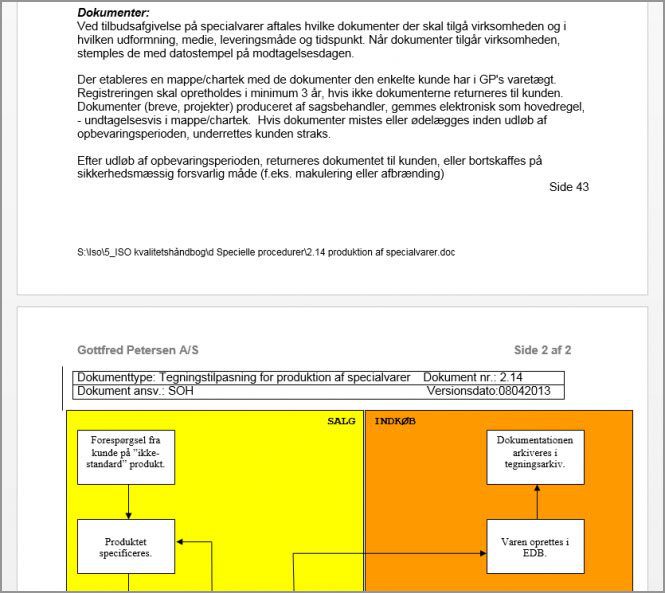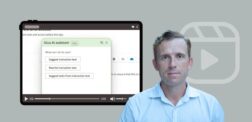
The state of ISO 9001:2015 in small businesses

This is a case on ISO 9001:2015 software for small businesses. It’s the first in a series of cases that are based on conversations with quality managers in SMEs. With this series, we want to give examples of the many ways in which companies work with management systems, software and processes.
Gottfred Petersen A/S in short…
Gottfred Petersen A/S is a Danish company with four main business areas; They are the supplier of materials in the areas of construction, protection, plastics and sanitary materials. The company was founded in 1960 and most of its 40 employees are co-located on Funen, Denmark. This case is based on an interview with Peter Nørgreen who is the company’s Quality Manager.
ISO 9001 on a daily basis
Peter Nørgreen sees the constant changes in laws and regulations as one of the challenges facing the building industry. This applies to everything from production to packaging. So how does the company handle this?
At the moment ISO 9001:2008 is being used as an overall guideline to how processes and activities are executed in the company. The organisational chart makes it clear who does what and who the employee refers to, Peter says. ISO 9001:2008 describes the processes, procedures and instructions for everybody to use and use as a guideline for work. The input on how to apply it in the daily work comes from personal networks and through experience gained along the way.
But is this easier said than done? I asked Peter Nørgreen if he, in his role of Quality Manager, ever struggles with getting all these good intentions to work in practice so that quality management isn’t just a certificate on the wall. To this he replied:
“Well, yes to some extent, but as Quality Manager, I put a great effort into introducing new employees to our system. We have a guideline on how to do this, just as we also ask about ISO when we audit internally, especially the descriptions of different processes in the company, but also operational goals, quality policies, and so on. Quarterly meetings are held to communicate new goals and changes. We also have a group of employees that handle complaints.”
How is quality management done in practice?
All employees use business intelligence from Targit as a daily tool. This way all employees have access to basically all data in real-time. Furthermore, it allows a push of information via email, tablets, iPhones so that relevant data is being pushed to the right employee. Peter Nørgreen explains it this way;
“Let’s say you want to know if a district or a customer differs in revenue with more than 3% if this happens the information is then sent to the right person who can proactively take action on this… As we work with data in real-time, it is possible to connect to all information in the company, furthermore, it makes sense to pre-define your cubes of data to be able to monitor and react to deviations/trends.”
How do you share processes and documents?
Peter explains how everybody is informed of a change by receiving an email with a notification and a brief explanation of the changes. This information is also available in the index of the company management system for everybody to see. This way everybody can view the changes on the intranet or in the shared directory.
“Each procedure, document and instruction have an owner that has to provide information within his or her field. When audited these are the typical procedures and processes that will be controlled – are they used the right way? are they still creating a form of value? etc.” – Peter Nørgreen
At Gottfred Petersen A/S all procedures, processes, instructions, policies, rules and standards are revised at least once a year to ensure that they are able to react proactively when, as Peter puts it, “the winds of change hit us.” Maintenance is done by Peter himself in Word:

The company has brought tools to help them but most work with developing, controlling and revising processes is done in-house. In the beginning, consultants were brought in, to ensure that the company met the specific requirements listed in the ISO 9001 standard.
“You might say that the ISO 9001 based quality manual is the construction that keeps the building together.”
Gottfred Petersen A/S has chosen to keep the quality manual electronic and available via an index for all employees. The manual links to all processes and documents in a shared drive. This way it often only requires revision in one document when something has to change.
Peter’s advice about ISO 9001:2015 software and when to start the certification process
Peter Nørgreen says that at first, you should focus on the fundamental idea of the company and from that figure where the company has its strengths, weaknesses, opportunities and threats. In other words, start by doing a SWOT-analysis to gain knowledge about your company’s starting point.
Also, he finds it important to evaluate the organisational structure to decide whether it is the right one. Are the right authorities placed with the right roles so that decisions can be made in the right time, at the right place and at the right cost? Also, a way of following up on successes and deviations is key.
Another piece of advice is to start with the necessary paragraphs in the ISO 9001:2015 standard. This way you will build up a clean process-oriented management system, with a focus on the essential business areas.
When working with quality management, be careful not to over-inform and create redundant data, but instead try to form a system with brief and precise statements. Use an ISO 9001:2015 software where you can create references and links to version-based documents;
This makes it a whole lot easier when editing and revising the efficiency of the system so that you do not have to go through the entire handbook every time something must be revised or added.”
As an experienced Quality Manager Peter Nørgreen recommends using a consultant in the start-up phase. It is a lot less time consuming when you have help to make sense of the ISO 9001:2015 standard and finding the right ISO 9001:2015 software to maintain your documents. Minimising risks and getting help to define the language, goals, processes, is just a part of this. When the structure is in place, then the Quality Manager can collect the knowledge needed.
“…e.g. by getting a Lead Auditor education and hereby be ready for changes in a constantly changing version and document controlled process. Remember: Always keep it simple.
Some last words of advice from Peter
“Trust is good but control is necessary.”
- Pictures and flow diagrams say more than a thousand words.
- Instructions should be very precise and brief or else they will not be read as they ought to be.
- Use storytelling, it makes the transition a lot easier when everybody has an understanding of how a quality management system can be a part of making the daily work fun and easy and create a more professional outcome internal as well as external.
These are the words from Peter from Gottfred Petersen A/S. Soon we’ll present another case and another perspective.
Frequently Asked Questions
The Small and Medium-Sized Enterprise took several steps to implement the ISO 9001 via the Cloud Quality Management System. These included defining quality objectives, creating a QMS manual with effective procedures, and conducting internal and third-party audits for certification.
The adoption of ISO 9001 led to enhanced customer satisfaction and streamlined processes, which fueled the SME’s growth. The established procedures also increased efficiency by cutting down on waste, thereby boosting productivity.
Although the blog doesn’t mention specific challenges, it’s common for companies to struggle with understanding the requirements of ISO 9001, having to tailor them to their business and changing well-established processes. To overcome these hurdles, the SME likely sought the help of consultants or used software solutions for guidance. They may have also conducted regular audits and trainings to ensure understanding and adherence to the new procedures among the employees. Platforms like Gluu can provide much-needed structure and guidance through this process.



